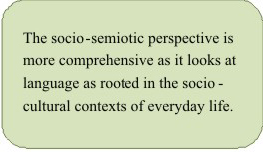Sociosemiotic perspective
This perspective views communication as an act that involves numerous codes. Nida points out how the impact of a verbal message is not that of words alone, but of extralinguistic and paralinguistic aspects like the background of the speaker, his/her sincerity, knowledge and expertise etc. It is not as if people are conscious of these elements, but they play a vital role in their response to a statement. Here we see an interplay of verbal and nonverbal codes that go into the process of communication. These codes are present in written communication also and hence they have a role in translation. paralinguistic aspects like the background of the speaker, his/her sincerity, knowledge and expertise etc. It is not as if people are conscious of these elements, but they play a vital role in their response to a statement. Here we see an interplay of verbal and nonverbal codes that go into the process of communication. These codes are present in written communication also and hence they have a role in translation.
Language is seen as a code that is embedded in the socio-cultural context and communication will be influenced by all these factors. Communication is seen as a dynamic activity, closely linked to the social customs and practices as well as individualistic peculiarities. It is also a reciprocal act – the sender awaits feedback from receptor through verbal and nonverbal codes. Translation that takes all these factors into account will be sensitive to source and receptor socio-lingual codes.
Nida outlines the advantages of the sociosemiotic approach:
-
It perceives language as the offshoot of a host of socio-cultural factors and hence rooted in the everyday world of reality, rather than in an ideal speaker community.
-
It can be verbally creative as its focus is on actually spoken language; it is not bound by reductive rules of language.
-
It does not conceive of language as a rigid system with clear cut boundaries and a well established meaning underlying it. It acknowledges the malleability of language and the indeterminacy of meaning.
-
It takes into account the interdisciplinary nature of codes, which tends to expand the boundaries of translation activity.
|